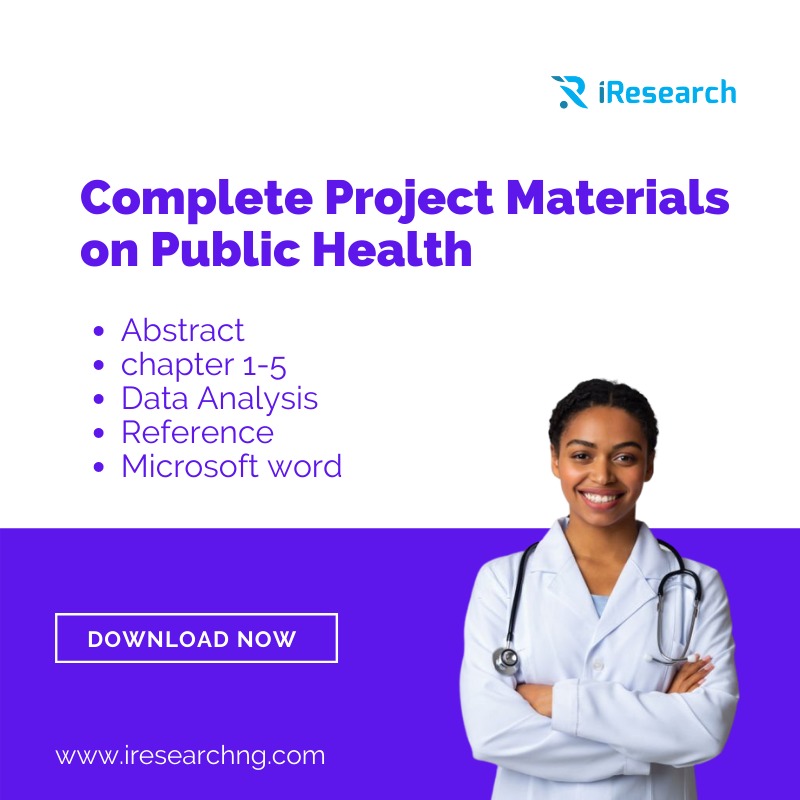



CHAPTER ONE
INTRODUCTION
1.1 Background of the study
Malaria is an acute febrile illness caused by Plasmodium parasites, which are spread to people through the bites of infected female Anopheles Mosquito. Malaria has been the focus of multiple declarations, and a range of targets have been set since the beginning of the millennium this is because approximately half of the world population is at risk of malaria.(WHO, 2015). According to Ukaegbu et al., (2014), Malaria is a life threatening disease caused by five species of protozoan parasite of the genus Plasmodium namely P. falciparum, P. vivax, P. malariae, P. ovale and P. knowlesi.
Globally, an estimated 3.3 billion people in 97 countries and territories are at risk of being infected with malaria and developing disease and 1.2 billion are at high risk as opined by WHO (2011); Iwuafor et al., 2016). Notably, nearly all human deaths by malaria are caused by P. falciparum, mainly in sub-Saharan Africa. It is estimated that 198 million cases of malaria occurred globally in 2013 and the disease led to 584,000 deaths representing a decrease in malaria case incidence and mortality rates of 30% and 47% since 2000, respectively (WHO, 2013 and 2014). It is considered a disease of poverty and duly recognized as a public health problem with overwhelming medical, social and economic implications (Isah et al., 2011). Within endemic countries, the poorest and most marginalized communities are the most severely affected, having the highest risks associated with malaria, and the least access to effective services for prevention, diagnosis and treatment (World Bank, 2014).
On the other hands, typhoid fever, also known simply as “typhoid” is a symptomatic bacterial infection due to Salmonella typhi equally called Salmonella enterica serotype Typhi (Modebe et al., 2014; Wain et al., 2015). It is acquired by the ingestion of food and/or water contaminated with the faeces of an infected person, which contain the bacterium, Salmonella enteric serovar typhi; humans are the only infected (Ukaegbu et al., 2014). Risk factors include poverty as a result of poor sanitation and poor hygiene (Wain et al., 2015). In the year 2000 and 2010, an estimated 21.7 million and 13.5 million typhoid fever illnesses were recorded. Between years 2000 and 2013, it resulted in estimated 217,000 and 161,000 deaths respectively (Crump et al., 2010; Buckle et al., 2010). Infants, children, and adolescents in south-central and Southeast Asia experience the greatest burden of illness (Crump et al., 2004). Nonetheless, outbreaks of typhoid fever are frequently reported from sub-Saharan Africa and countries in Southeast Asia (Muyembe et al, 2009 and Baddam et al, 2012).
Consequently, due to the geographical overlap of both infections, co-infections are very common. However, the precise incidence of the concurrent malaria and typhoid fever in most geographical areas is largely uncertain, as both share social circumstances which are imperative to their transmission; individuals in areas endemic for both diseases are at substantial risk of contracting both these diseases, either concurrently or an acute infection superimposed on a chronic one (Keong et al., 2006).
1.2 Statement of the problem
1.3 Objective of the Study
1. To determine the prevalence of malaria and typhoid fever among individuals attending Tela PHCC in Gassol LGA Taraba State.
2. To investigate the rate of co-infection with respect to the use of widal test and blood culture methods for diagnosing typhoid fever in Tela PHCC in Gassol LGA Taraba State.
3. To ascertain the overall prevalence of malaria and typhoid fever co- infections among patients in Tela PHCC in Gassol LGA Taraba State.
1.4 Research Question
1. What is the prevalence of malaria and typhoid fever among individuals attending Tela PHCC in Gassol LGA Taraba State.
2. What is the rate of co-infection of malaria and typhoid in individuals attending in Tela PHCC in Gassol LGA Taraba State using use of widal test and blood culture methods for diagnosing typhoid?
3. What is the overall prevalence between malaria and typhoid fever infections among patients in Tela PHCC in Gassol LGA Taraba State.
1.5 Significance of the study
The findings from this study would be useful to the following; patient, ministries of health, hospitals, policy makers and health practitioners . To health practitioners, the result of the study would help them in caring adequately and planning well for patients attending the clinic when treating them for malaria and typhoid. This study will help policy makers to formulate relevant policies on malaria and typhoid prevention .This study would be useful to government and parastatal by educating them on the need to provide concerted health education intervention to improve the attitude and knowledge of Taraba State resident regarding poor health seeking behavior and adequate strategies for malaria and typhoid prevention especially with the use of insecticide, treated Net, adequate funding, etc. necessary for controlling and reducing incidence of malaria and typhoid in the general public.
1.6 Scope of the study
The scope of this study borders on the assessment of malaria and typhoid co-infection among individuals attending Tela PHCC in Gassol LGA Taraba State. The study will further discuss the risk factors leading to malara and typhoid infection. The study will also examine rate of co-infection of malaria and typhoid in individuals attending in Tela PHCC in Gassol LGA Taraba State using use of widal test and blood culture methods for diagnosing typhoid.
1.7 Limitation of the study
Financial constraint– Insufficient fund tends to impede the efficiency of the researcher in sourcing for the relevant materials, literature or information and in the process of data collection (internet, questionnaire and interview).
Time constraint– The researcher will simultaneously engage in this study with other academic work. This consequently will cut down on the time devoted for the research work.
Find Other related topics on:
NOT THE TOPIC YOU ARE LOOKING FOR?
Once payment is made, kindly send us your project topic, email address and payment name to +234 810 144 4147
Once payment is confirmed, Project materials will be sent to your email